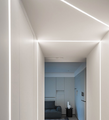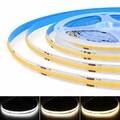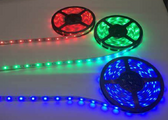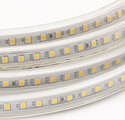12 key performance indicators of LED strip lights
When we design and receive orders, we must not forget the performance parameters of LEDs (the core part of the entire LED). The following is divided into 12 keywords for detailed analysis.
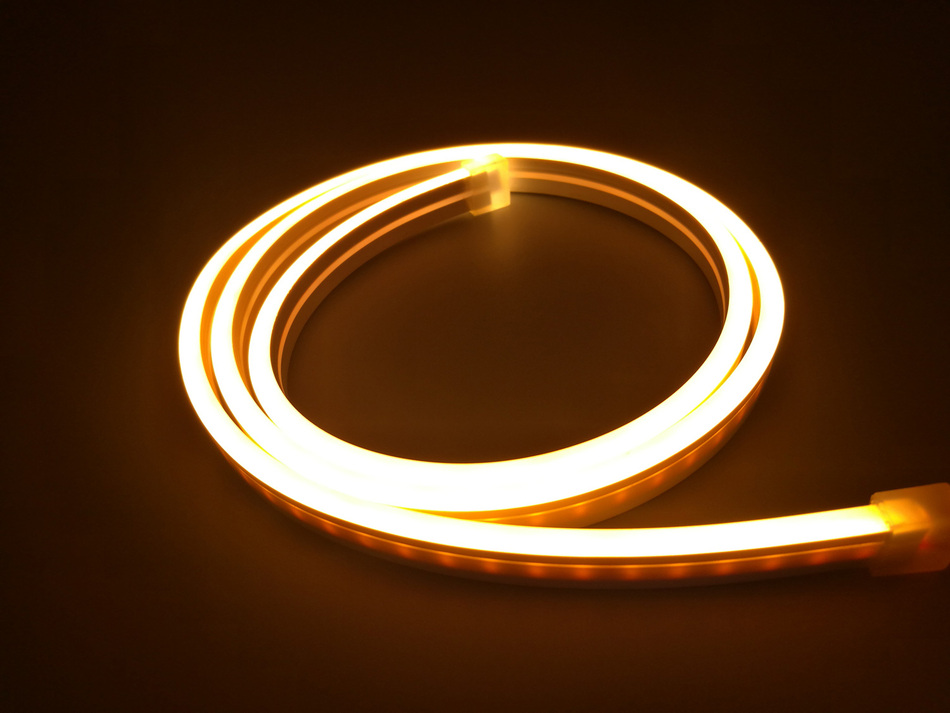
LED color
The color of LED is a very important indicator, which must be marked on every LED-related lighting product. Currently, the colors of LED mainly include red, green, blue, cyan, yellow, white, warm white, amber, etc. This parameter must not be forgotten when we design and receive orders. Because the colors are different, the related parameters also vary greatly.
LED current
The forward limit (IF) current of LED is mostly 20MA, and the light attenuation current of LED cannot be greater than IF/3, which is about 15MA and 18MA. The luminous intensity of LED is only proportional to IF within a certain range. When IF>20MA, the enhancement of brightness cannot be distinguished with the inner eye.
Therefore, it is generally reasonable to choose the operating current of LEDs around 17-19MA. The above is for LEDs between ordinary low-power LEDs (0.04-0.08W), except for some high-power LEDs (some rated around 40MA). value).
In addition to the continuous development of technology, high-power LEDs are also emerging, such as 0.5W LED (IF=150MA), 1W LED (IF=350MA), 3W LED (IF=750MA) and other more specifications. Here I will introduce I won’t introduce them one by one.
LED voltage
Generally speaking, LED is a forward voltage, which means that the positive electrode of the LED is connected to the positive electrode of the power supply, and the negative electrode is connected to the negative electrode of the power supply.
Voltage is related to color. The voltage of red, yellow, yellow and green is between 1.8-2.4v. The voltage of white, blue and green is between 3.0-3.6v.
What should be reminded here is that the voltage of LEDs produced in the same batch will also have some differences. It should be based on the voltage provided by the manufacturer. When the outside temperature increases, the VF will decrease.
LED reverse voltage VRm
The maximum reverse voltage allowed to increase. If the value is exceeded, the LED may be damaged by breakdown.
LED color temperature
Expressed in absolute temperature K, that is, a standard blackbody is heated. When the temperature rises to a certain level, the color begins to change from dark red to light red to orange to white to blue. When a certain light source has the same color as the blackbody, the blackbody will be The absolute temperature is called the color temperature of the light source.
Because the correlated color temperature is actually the evaluation value of the light color performance of the light source when the black body radiation is close to the light color of the light source, it is not an accurate color comparison. Therefore, two light sources with the same color temperature value may still have different light color appearance. There are slight differences. Color temperature alone cannot tell how well a light source renders color on an object, or how well the color of an object is reproduced under that light source.
Below are the correlated color temperatures of different light source environments.
In addition, the color temperature of the light source is different, and the light color is also different:
Color temperature below 3000k has a warm feeling and achieves a stable atmosphere;
The color temperature is between 3000k and 5000k, which is the middle color temperature and has a refreshing feeling;
The color temperature is above 5000k, which makes it feel cold.
Luminous intensity
The unit is candela, which is cd. The luminous flux emitted by a light source in a unit solid angle in a given direction is defined as the luminous intensity (degree) of the light source in that direction. The luminous intensity is for a point light source, or the size of the luminous body is compared with the irradiation distance. Small occasion. This quantity indicates the ability of the luminous body to converge in space.
It can be said that luminous intensity describes how "bright" the light source is, because it is a common description of optical power and convergence ability. The greater the luminous intensity, the brighter the light source appears, and the brighter the object illuminated by the light source under the same conditions. Therefore, this parameter was used to describe the flashlight earlier.
Nowadays, LEDs are also described in this unit. For example, if an LED is 15,000, the unit is mcd. 1,000mcd=1cd, so 15,000mcd is 15cd. The reason why LED is expressed in milli-cd (mcd) instead of directly in cd is because the earliest LEDs were relatively dark in the past. For example, the luminous intensity of the standard 5mm LED in 1984 was only 0.005cd, so it was expressed in mcd.
The disadvantage of using luminous intensity to express "brightness" is that if two LEDs have exactly the same tube core, the luminous intensity will be high if the degree of convergence is good. Therefore, when purchasing LEDs, users should not only focus on the high I value, but also look at the illumination angle. Many LEDs with high I values are achieved not by improving their own emission efficiency, but by lengthening the lens and narrowing the illumination angle. Although this is useful for LED flashlights, the viewing angle is also limited.
In addition, for the same tube core LED, the I value of 5mm diameter is more than double that of 3mm diameter, but only 1/4 of that of 10mm diameter, because the larger the lens, the better the convergence characteristics.
LED luminous flux
The unit of lumens is lm. The amount of light emitted by a light source per unit time is called the luminous flux of the light source. Similarly, for a light source, this quantity describes the total amount of light emitted by the light source, and is equivalent to the optical power. The greater the luminous flux of the light source, the more light is emitted.
For isotropic light (that is, the light from the light source is emitted with the same density in all directions), then F=4πI. That is to say, if the I of the light source is 1cd, the total luminous flux is 4π=12.56 lm. Compared with mechanical units, luminous flux is equivalent to pressure, and luminous intensity is equivalent to pressure. If we want the illuminated point to look brighter, we must not only increase the luminous flux, but also increase the means of aggregation, which actually means reducing the area, so as to obtain greater intensity.
You must know that luminous flux is also a man-made quantity, which may be different for other animals, let alone a completely natural thing, because this definition is entirely based on the response of the human eye to light.
The human eye has different perceptions of light of different colors, and this perception determines the conversion relationship between luminous flux and optical power. For the 555nm yellow-green light that the human eye is most sensitive to, 1W = 683 lm. That is to say, 1W of power is converted into light with a wavelength of 555nm, which is 683 lumens. This is the maximum light conversion efficiency and is also the calibration value, because the human eye is most sensitive to 555nm light.
For other colors of light, such as 650nm red, 1W of light is only equivalent to 73 lumens. This is because the human eye is not sensitive to red light. For white light, it depends on the situation, because light with many different spectral structures is white.
For example, the white light of LED, the white light of TV and sunlight are very different, with different spectrums.
Taking the commonly used white LED lumens as an example: 0.06W→3-5LM, 0.2W→13-15LM, 1W→60-80LM. (for reference only)
LED illumination
The unit of lux is lx (formerly called lux). The illumination produced by a luminous flux of 1 lumen evenly distributed on a surface of 1 square meter.
Color rendering
The degree to which the light source renders the color of the object itself is called color rendering, which is the degree to which the color is realistic; the color rendering of the light source is indicated by the color rendering index, which indicates that the color of the object under light is better than the reference light (sunlight) when illuminated Color deviation can more fully reflect the color characteristics of the light source.
Light sources with high color rendering properties perform better on colors, and the colors we see are close to natural colors. Light sources with low color rendering properties perform poorly on colors, and the color deviations we see are also larger.
There are two types of color development:
Faithful color rendering: To accurately represent the original color of a substance, a light source with a high color rendering index (Ra) is required. Its value is close to 100, which means the color rendering is the best.
- Effect color development: To clearly emphasize a specific color and express the beauty of life, you can use the additive color method to enhance the color development effect.
Glare
If there are extremely bright objects or strong brightness contrast in the field of view, it can cause visual discomfort called glare. Glare is an important factor affecting lighting quality.
The service life of LED
In general instructions, LEDs can be used for more than 50,000 hours, and some manufacturers claim that their LEDs can operate for about 100,000 hours. The main problem here is that LEDs do not simply stop functioning, and their rated service life cannot be calculated using traditional light fixture measurements.
In fact, when testing the life of an LED, no one will be waiting for it to stop functioning. However, there are other ways to calculate the service life of LEDs. The reason why LED is long-lasting is that it does not have the problem of filament melting. The LED will not stop functioning directly, but it will gradually degrade over time.
Some predictions show that high-quality LEDs can maintain more than 60% of the initial light brightness after 50,000 hours of continuous operation. Assuming that the LED has reached its rated service life, it may actually still be emitting light, but the light is very weak.
To extend the service life of LEDs, it is necessary to reduce or completely dissipate the heat generated by LED chips. Heat is the main reason why LEDs stop functioning.
LED light angle
The light-emitting angle of a diode is its light scattering angle, which is mainly controlled by adding scattering agents during the production of the diode. There are three major categories:
(1) High directivity.
Generally, it is a pointed epoxy package or a metal reflective cavity package without adding scattering agent. The luminous angle is 5°-20° or less, and has high directivity. It can be used as a local lighting source, or used in conjunction with a light detector to form an automatic detection system.
(2) Standard type.
Usually used as an indicator light, its luminous angle is 20°-45°.
(3) Scattering type.
This is an indicator light with a larger viewing angle, with a lighting angle of 45°-90° or greater, and a larger amount of scattering agent.
The above are 12 key points that we must pay attention to when choosing LED products. You may feel that you are not so professional, but when you understand, you are on the road to professionalism. Although the road is long, I am moving forward.


